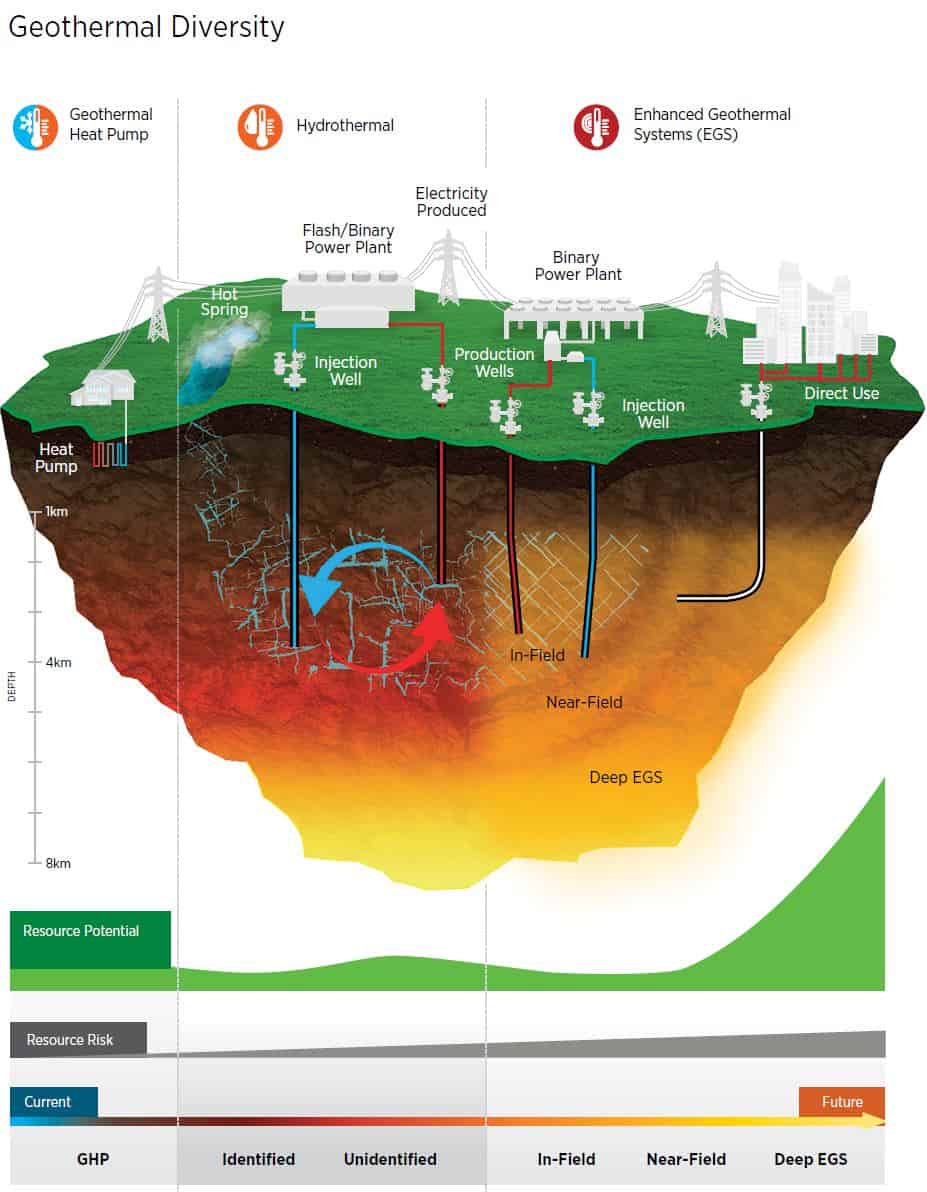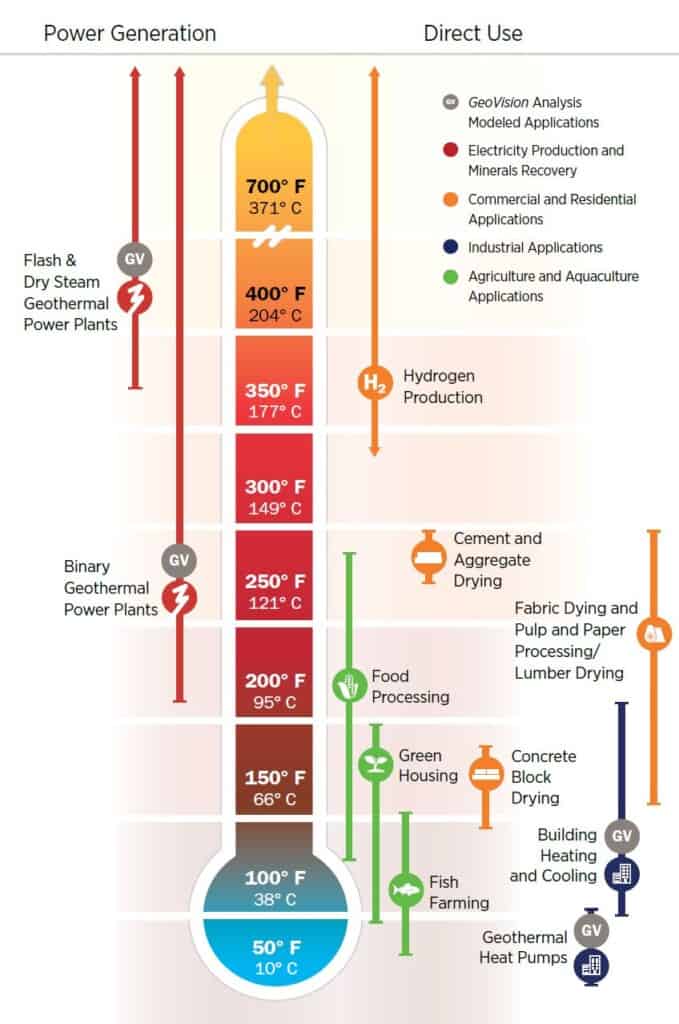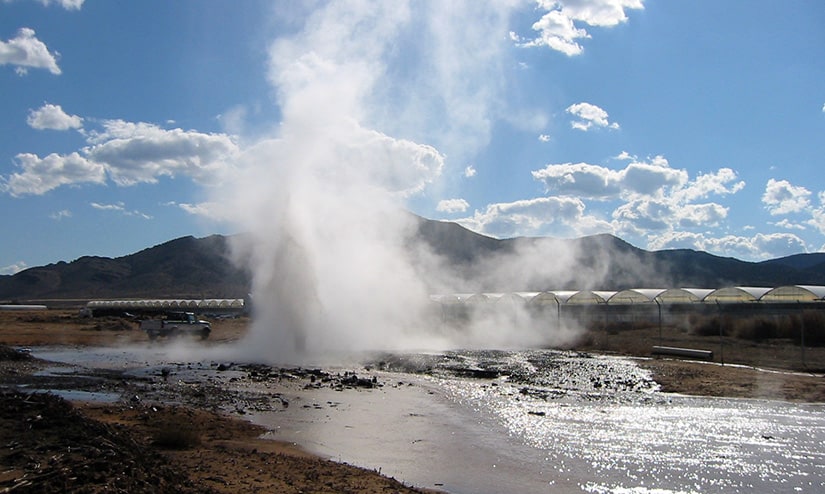Geothermal energy has two primary applications for society: heating/cooling and electricity generation. In order to develop Earth’s geothermal resources, scientists and engineers must understand the details of various geothermal energy systems and the best application suitable for the system.
There are two categories of geothermal systems in terms of resource temperature: high enthalpy (volcanoes, geysers) and low enthalpy forms (heat stored in rocks in the Earth’s crust). Nearly all heating and cooling applications utilize low enthalpy heat and power generation applications are served well with high enthalpy heat. Geothermal Energy Systems can also be categorized based on the depth and whether the system is natural or engineered (also known as enhanced).1 National Geographic. (n.d.). Geothermal Energy. National Geographic Education. https://education.nationalgeographic.org/resource/geothermal-energy/2University of Michigan Center for Sustainable systems. (2022). Geothermal Energy Fact Sheet. Pub. No. CSS10-10. https://css.umich.edu/publications/factsheets/energy/geothermal-energy-factsheet
Helpful Vocabulary
Enthalpy: Often in thermal calculations, a thermodynamic heat function named enthalpy is used to quantify the energy the fluid is carrying. This definition is useful for categorizing geothermal resources and designing continuous industrial processes (with fluid flow) and will be used in the course design activity.
Geothermal Diversity
Geothermal Energy Systems
The three main types of geothermal energy systems are:
- High Temperature Geothermal Systems
We will highlight the most common of these, Hydrothermal Systems: natural high enthalpy resources with applications for power generation, often found in areas close to the Ring of Fire—a plate tectonically active region around the edges of the Pacific Ocean where many volcanic eruptions and earthquakes occur. - Enhanced (Engineered) Geothermal Systems or EGS
These EGS systems are engineered high/medium enthalpy resources, typically used for power generation applications. - Low Temperature Geothermal Systems
We will highlight Geothermal Heat Pumps: traditionally shallow and low enthalpy systems acting as heat exchangers to deliver heating and cooling to surface spaces.
The graphic below illustrates examples of the three types of geothermal energy systems: geothermal heat pump (low temperature system), hydrothermal (high temperature system), and enhanced geothermal systems (EGS). The diagram shows each system’s depth, required subsurface condition, and application. EGS systems continue to remain in the research and development phase due to engineering complexities and economic feasibility, so companies have yet to deploy commercial-scale systems.

Geothermal Applications
Both the energy conversion process and end-use application of geothermal varies with the quality of the resource and is primarily a function of temperature. Once a geothermal power plant is constructed and in operation, the energy produced is “always on.” Geothermal resources in a range of temperatures can be used economically for a variety of electric and nonelectric applications.4U.S. Dept. of Energy. (2019, May). GeoVision: Harnessing the Heat Beneath Our Feet. https://www.energy.gov/eere/geothermal/articles/geovision-full-report-0. Let’s consider some of these different applications.
Geothermal systems can be used for cooling and heating, agricultural and industrial process heating, and electrical power generation. The schematic below illustrates the temperature and corresponding potential applications in detail. Flash and dry steam geothermal power plants require the highest temperatures. Flash steam power plants are the most common forms of electricity production and use geothermal reservoirs of water with temperatures greater than 360°F (182°C). Hydrogen production from electrolysis can be achieved using geothermal energy for the required electrolysis to separate hydrogen out from other compounds, but, as shown below, requires high temperature systems. Binary geothermal plants operate on water at lower temperatures of about 225-360°F (107-182°C). Lower temperature applications like food processing, building cooling and heating, green housing, fish farming, and geothermal heat pumps are typically found at temperatures of 300°F (150°C) or less.5National Renewable Energy Laboratory (NREL). (n.d.) Geothermal Electricity Production Basics. https://www.nrel.gov/research/re-geo-elec-production.html

As noted previously, geothermal power production can occur at resource temperatures below 150°C, but such projects tend to be the exception and require a combination of technical, economic, and access factors that enable development.7U.S. Dept. of Energy. (2019, May). GeoVision: Harnessing the Heat Beneath Our Feet. https://www.energy.gov/eere/geothermal/articles/geovision-full-report-0.

Which is not a primary type of geothermal systems?
Incorrect
Incorrect
Correct
Hydrothermal Geothermal Systems are a subtype of a high temperature geothermal systems. For example, a high temperature system could be dry.
Incorrect
A newly discovered geothermal resource has a temperature of 150 °F (66 °C). Select the potential applications for this resource based on the information from this page.
Correct
Incorrect
Binary geothermal power plants would require geothermal temperatures greater than 150 °F.
Correct
Correct
Incorrect
Hydrogen production would require geothermal temperatures greater than 150 °F.
Image Credits
- Geothermal-diversity-GeoVision-2.3: DOE, GeoVision
- Continuum-geothermal-applications-GeoVision-2.7: DOE, GeoVision
- Milgro Nursery: NREL